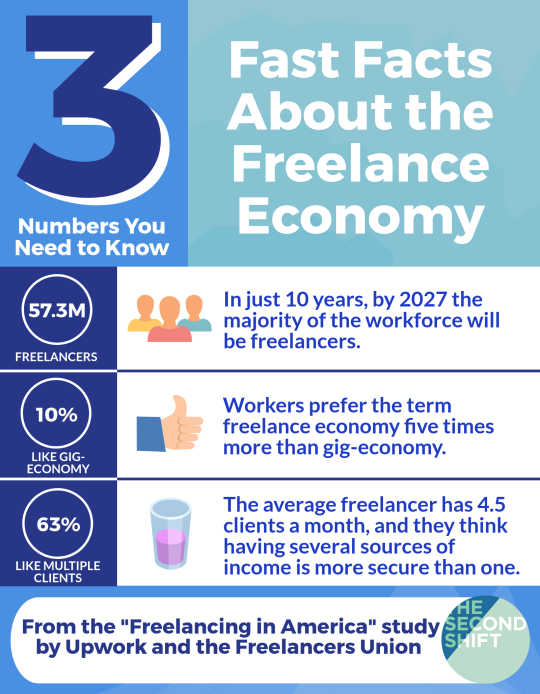
The Majority of the Workforce will be Freelancers in Just Ten Years
A New Study by Upwork and the Freelancers Union Provides a Lens into the Future of Work
Last month, a new study on the future of work by Upwork and the Freelancers Union looked at the growing number of freelancers to see how the gig-economy is growing. The study revealed some interesting statistics about the freelance workforce; we took a deep dive into the results:
· 57.3M people freelance.
· Only 10% of freelance workers like the name gig-economy – they prefer freelance economy—(we agree!)
· 63% of freelancers think having several sources of income and multiple clients more secure than one – the average freelancer has 4.5 clients a month.
Here’s the who, what, where, when, why and how of the freelance economy:
Who is the driving force behind this rapid change?
“Almost half of working millennials (47%) freelance.” As a result, the common negative perception of freelance as a primary earnings method shifted, with 67% of people agreeing that it’s a stable form of work.
What is likely to keep the freelance economy going?
“Freelancers are more realistic about artificial intelligence’s (AI) impact than non-freelancers.” As a result, they are more likely to seek the training they need to continue to compete in a technologically changing workplace – “65% of full-time freelancers are updating their skills to ensure that they are marketable as the job market evolves.”
Where are freelancers earning their living?
The majority of the freelance economy isn’t moonlighting; 29% work full-time, 53% work part-time, and only 16% work occasionally for extra income in addition to another traditional job. “Most freelancers started within the last three years,” and freelancers are increasingly choosing to join the freelance economy by choice, which is indicative of a move to towards more creative outlets to earn a living, often not requiring formal education. Freelancers are finding their work through friends and family, professional contacts and social media – personal connections are more powerful then technological ones—(something we hope we are solving!)
When are freelancers working?
“Most freelance weekly: freelancers indicate, on average, having 27 different clients within their last six months of work,” and 52% of freelancers will work for the same clients repeatedly on different projects with most full-time freelancers working 36 hours per week. Among workers who find their projects online, 77% start their projects within a week – 21% start the same day.
Why is freelancing the wave of the future?
“54% of the entire U.S. workforce is not very confident that the work they do today is likely to exist in 20 years,” and both traditional and freelance workers agree. The study goes on to differentiate that freelancers are more aware of how their work is changing due to increased AI and robotics used in the workplace. Ultimately, the data reveals that the changing nature of the freelance workforce makes them more adaptable and is why they are likely to outnumber traditional workers in ten years time. Perhaps more importantly, 77% of workers believe that these same technological improvements are making it easier for them to find freelance work.
How will this impact our economy?
The numbers don’t lie, the freelance economy is good for the U.S.; “freelancers contribute approximately $1.4 trillion to the U.S. economy annually – an increase of almost 30% since last year.” Part of the economic boost comes from freelancer’s preference to purchase their own benefits in the marketplace; 67% agree that “a healthy freelance economy boosts America’s middle class.” A current practice they’re likely to be able to continue because 72% of freelancers are willing to vote across party lines for candidates that support the freelance economy. They’ll be able to have a tangible financial impact on elections as well because 36% earn $75,000 or more – double the percentage that did from 2014. Further to, 66% say they earn more in the freelance economy then they did in a traditional workplace; 75% of them earned more in just their first year, with 37% earning more immediately.
One last interesting fact: “Freelancers skew more male than U.S. workers overall.” Ladies, given all the benefits the freelance economy brings, let’s get out there!
The data proves The Second Shift model and our members know that the findings of the study are true. We are the vanguard of the future of work– so let’s get more women to join us! Refer 5 new members and you will get a surprise thank you from us!